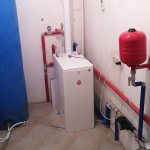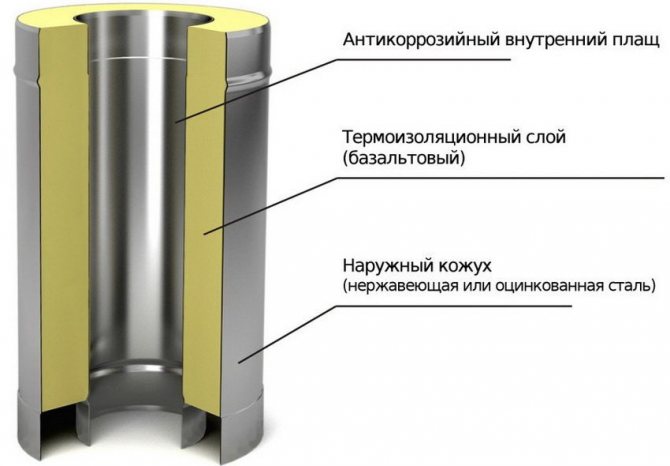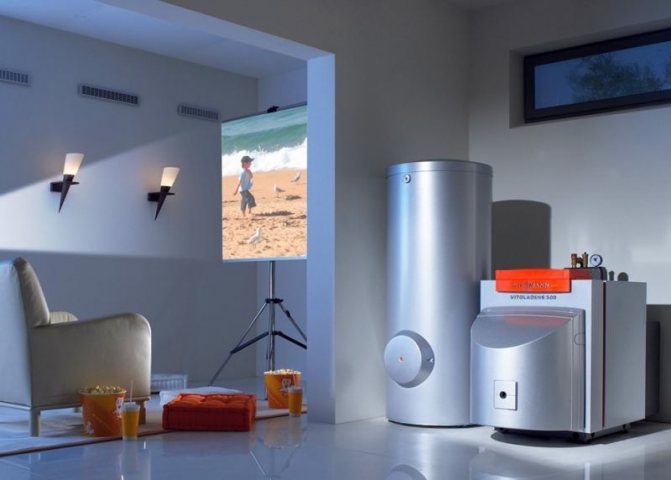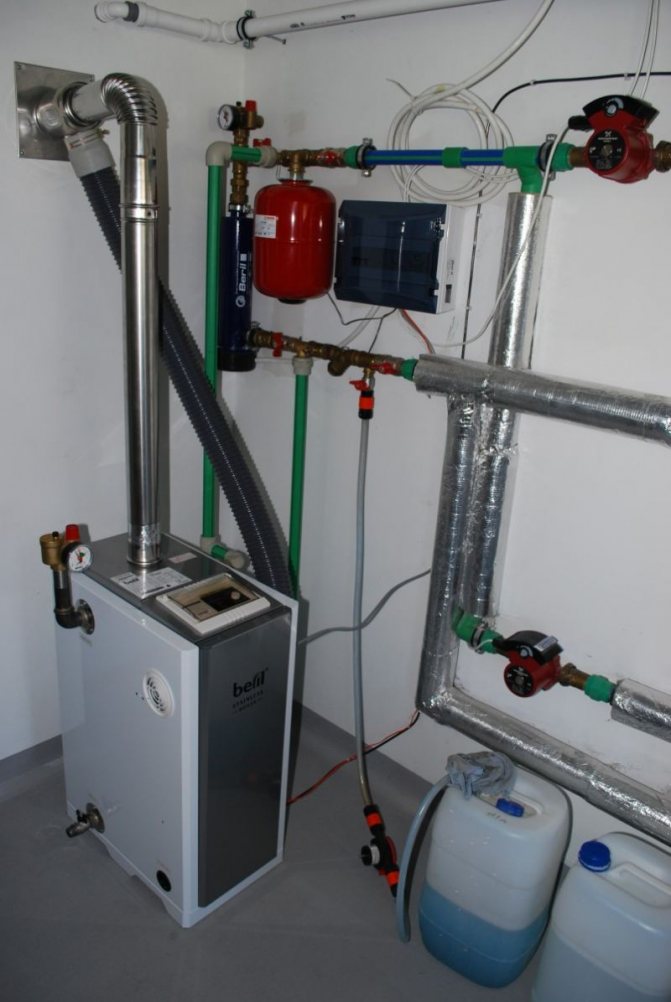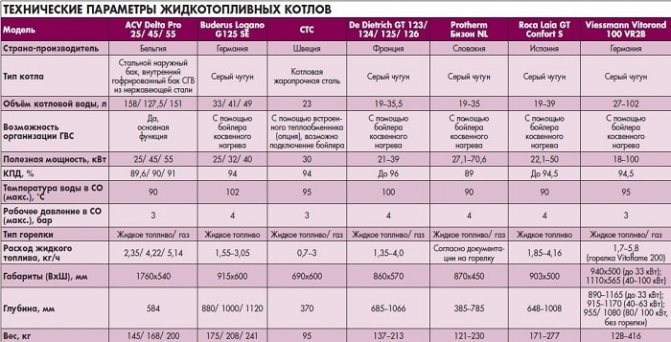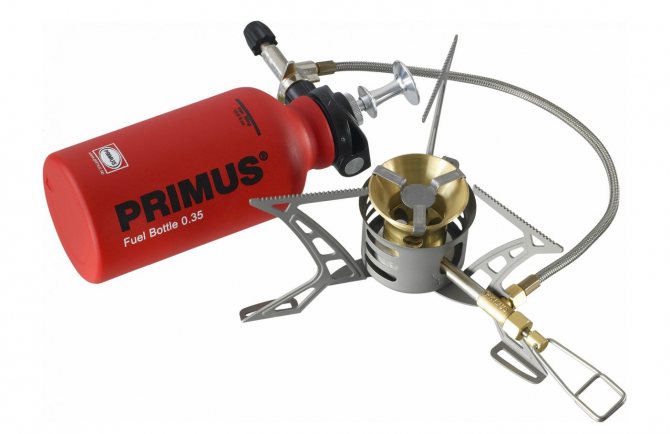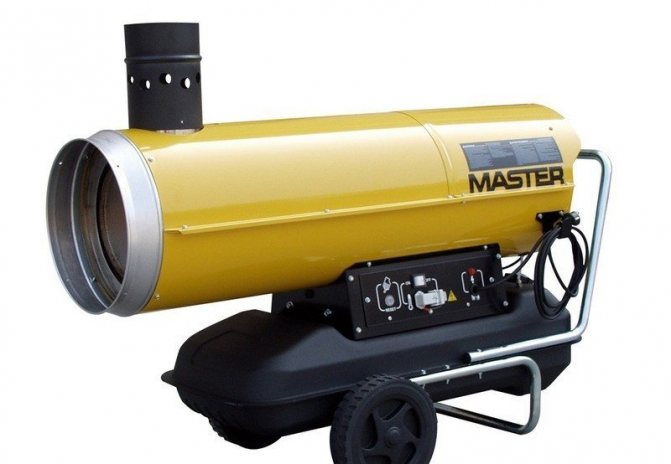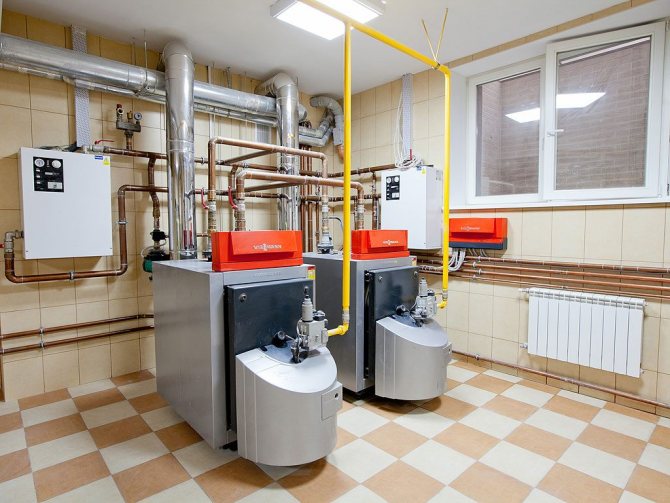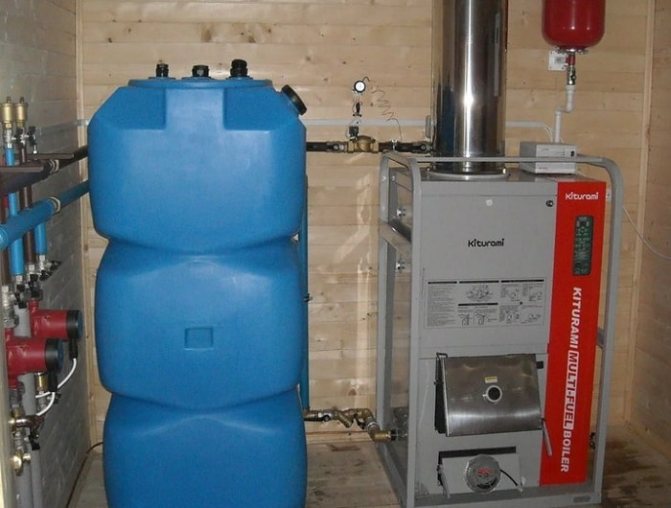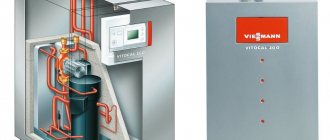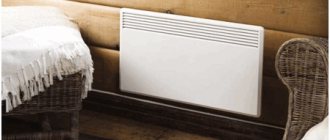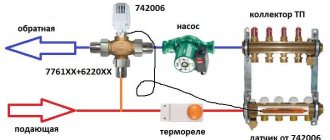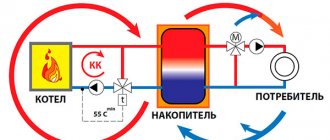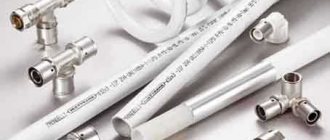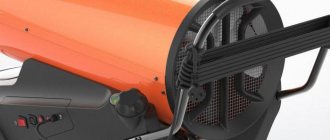Diesel fuel oil boilers occupy about 20% of the market. With a reliable power supply and regular maintenance, they are extremely reliable and durable. Diesel boilers, on average, have a higher efficiency than gas or solid-fuel ones, the efficiency is 90-96%, they do not require costly organization of a gas pipeline and paperwork, large rooms for storing fuel, after starting they are completely autonomous.
However, the high cost of diesel fuel is the reason for high operating costs: higher than gas and even solid fuel, but cheaper than electric boilers. High operating costs can often be offset by purchasing diesel fuel at wholesale prices or from local acquaintances.
What are diesel heating boilers
What are they for and how they are used

Diesel Kiturami Turbo and plastic fuel storage tank. The diesel is supplied by a fuel pump.
The main reasons for choosing boilers operating on diesel fuel are:
- lack of a gas pipeline in the place of residence;
- lack of desire in a constant fire with wood or coal, increased maintenance and cleaning of heating equipment, organization of storage of large volumes of solid fuel;
- availability of free access to diesel fuel or the ability to purchase it at a bargain price (from agricultural enterprises, tractor drivers, KAMAZ or bus drivers);
- small heated area, within 40-100 m2.
Even if there is a gas main in a residential area, the cost of connecting to it (permission, project, materials, etc.) is quite high. At the same time, the initial costs for organizing heating with a diesel boiler are minimal: a permit is not required, only a tank for storing diesel fuel is required (up to 0.8 m3 can be stored directly in the boiler room, when heating 100 sq. M. This volume is enough for almost the entire heating season).
Device and principle of operation


The device of diesel boilers using the example of Viessmann Vitorond 200
Diesel heating boilers differ from gas boilers only with a burner: it is equipped with a turbocharger, which provides the required pressure and atomizes fuel through the combustion chamber.
Also, diesel fuel requires preheating before spraying; special nozzles are used for spraying. Such a burner device implies a constant power supply, so boilers running on diesel fuel cannot be non-volatile. In domestic conditions with a high probability of power outages, it is recommended to additionally purchase a diesel generator.
In view of the difference only in the burner design, universal gas-diesel models are common, in which the conversion from gas to diesel and vice versa is done by simply changing the burner. Models with a replaceable burner are justified for the temporary use of diesel fuel, when it is planned to connect to the gas main in the future or if there is free, but not constant access to diesel fuel.
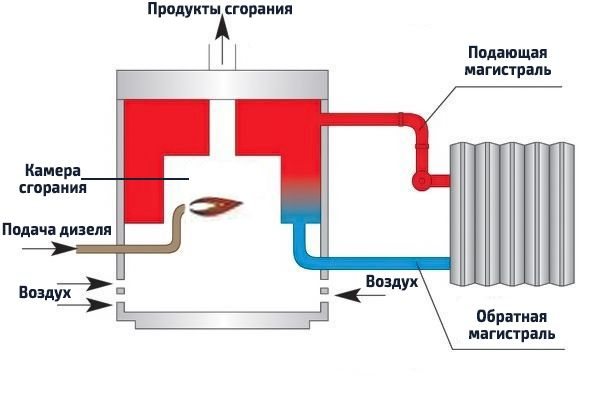

Otherwise, the principle of operation of household diesel boilers is standard:
- The fuel sprayed by the burner nozzles ignites and burns.
- The walls of the combustion chamber are a heat exchanger with a coolant inside.
- The heat exchanger transfers heat energy to the heat carrier, which circulates naturally or forcibly (with the help of a circulation pump) through the heating system.
Operation specifics
Burners of diesel heating boilers work quite noisy, even with a closed combustion chamber they fill the space with the smell of diesel fuel, therefore, a separate boiler room must be allocated for the operation of the boiler unit. The room requirements are the same as when installing a gas boiler, i.e. in accordance with SNiP 42-01 and MDS 41.2-2000, namely:
- ceiling height - at least 2.5 m with a room area of more than 4 m2;
- the presence of an openable window with an area of 0.03 m2 per cubic meter. meter of the volume of the room + structures with a fire resistance limit of at least REI 45, protecting the boiler room from the neighboring ones;
- there should be a free space of 1 meter in front of the boiler;
- doors with a width of at least 80 cm and a bottom gap of at least 2 cm;
- supply ventilation at the rate of at least 8 cm2 for each kW of boiler power, from neighboring rooms - at least 30 cm2 / kW.
- the boiler is connected to the mains with a separate three-core cable (usually included), through a separate RCD (the rating of which is always indicated in the boiler passport).
- the presence of a separate grounding bus in the boiler room, to which the boiler body is subsequently connected. In general, a diesel boiler is grounded in the same way as a gas boiler.
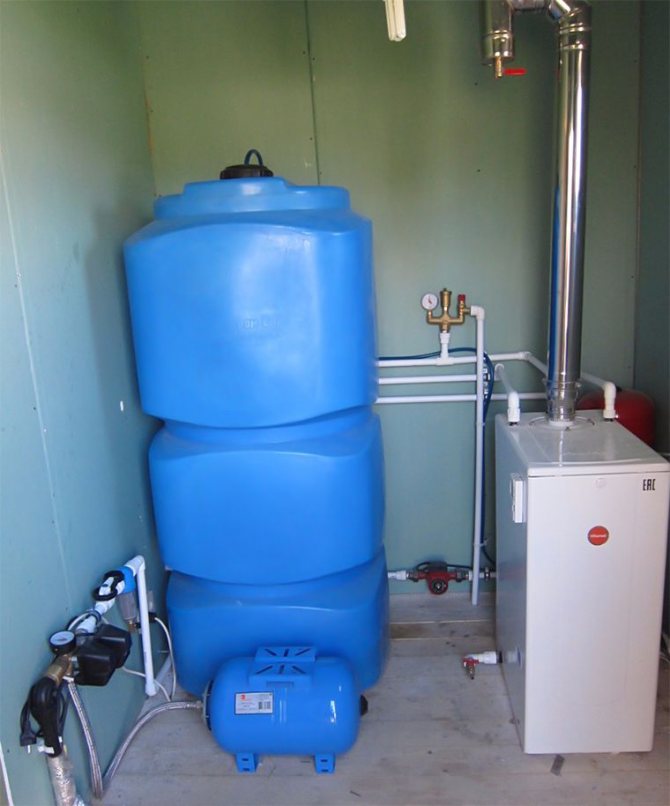

Organization of a boiler room with a fuel storage tank.
The fuel storage tank is also installed in the boiler room. With a volume of more than 0.8 m3, it must be taken out, but it should be borne in mind that the choice of diesel models is greatly narrowed: the boiler fuel pump must have an appropriate suction power. As a container, special tanks are used for storing diesel, usually made of strong plastic, resistant to aggressive liquids and external influences.
For external storage, 2 options are used: a set of plastic tanks connected by a pipeline or an underground plastic / metal tank (like a gas holder).
When storing above ground, it is imperative to insulate the tanks and the pipeline, since even at + 5 ° C the viscosity of diesel fuel increases, which complicates its transportation and increases the load on the fuel pump. It is not recommended to place containers in direct sunlight. You can also use frost-resistant diesel fuel, but the cost of using such fuel is simply unjustified.
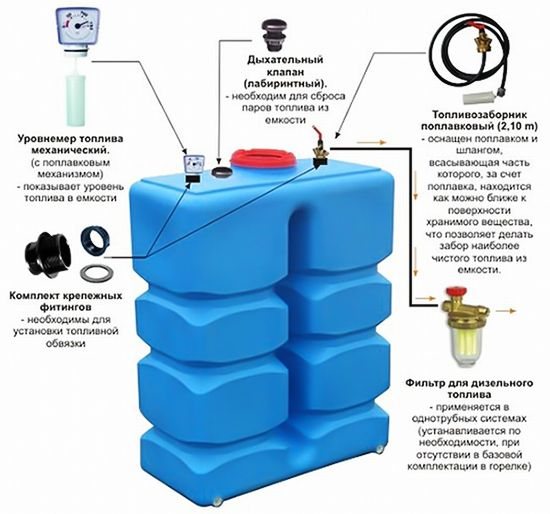

The most profitable and widespread storage option is underground, since the layer of earth provides a stable temperature both on hot days and in frosts. In addition, the fire hazard of an underground tank is minimal, and the cost of the organization is often more profitable than in the above-ground version.
Most diesel boilers have a closed combustion chamber, so an inexpensive coaxial (side) chimney is sufficient to remove the combustion products, the diameter of which must match the boiler outlet. The only caveat is that the chimney must be placed at a slight angle in order to avoid the condensate formed in the chimney from getting back into the boiler.
Condensation is a natural process, the phenomenon is also called the dew point, its value is usually 7-10 degrees below the temperature of the flue gases (for example, at a smoke temperature of 85 ° C, dew point - 78 ° C). Therefore, during cooling in the outer part of the chimney, condensate, hazardous to the metal components of the boiler, forms.
In addition to placing the chimney at an inclination of 2-3 degrees, the formation can be prevented by insulating the outer part of the chimney. The formation of condensate is characteristic only of convection models; in condensing boilers, the temperature of the exhaust gases practically corresponds to the atmospheric one.
How to choose a room thermostat and save up to 30% per month on heating
Device and features
A modern diesel boiler has a simple device:
- Burner.
- Pump.
- Fuel filter.
- Temperature control sensors.
- Remote control panel.
The diesel system works this way. Fuel enters the burner, mixes with air, atomizes, for which a fan is used. Further, ignition occurs in the combustion chamber, heating of the coolant and the walls of the chamber. The chimney removes the gases generated by the combustion of fuel.
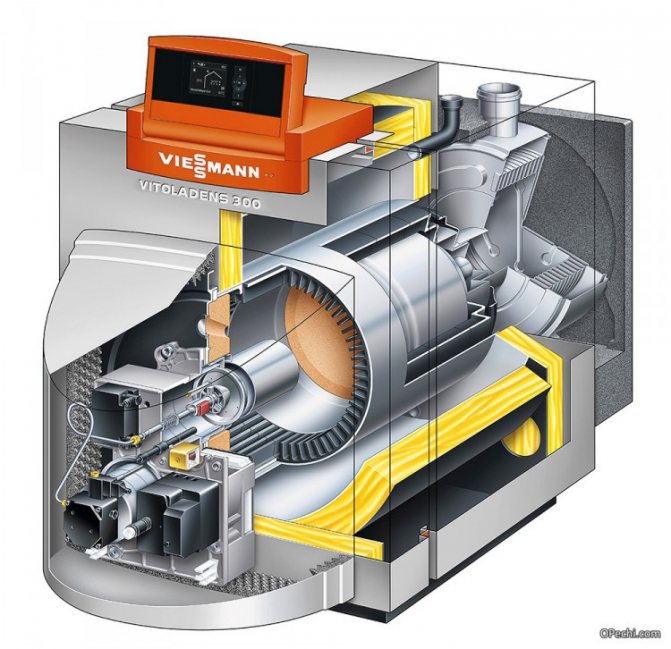

Diesel boiler structure
Heating diesel boilers have structural similarities to gas ones, but they are fundamentally different from infrared ones. The structure of the burner is different. Therefore, versatile dual fuel diesel stoves work by changing the attachment burner. Models with built-in burner cannot be retrofitted. This reduces their weight and cost.
Diesel fuel consumption
Specific heat of combustion 1 liter. diesel fuel - 10 300 kcal or 11.9 kW. This means that to obtain 1 kW of thermal energy, it is necessary to burn 0.084 liters. diesel fuel. It is also worth considering the efficiency, which, depending on the model, averages 90-95%, which means that about 5-10% of thermal energy is not transferred to the coolant.
Total, according to approximate calculations, calculations diesel boiler fuel consumption = Boiler power, kW / 10.
Often, the indicators are already indicated in the boiler passport. For example, the well-known budgetary Kiturami TURBO 13R (13 kW) with an efficiency of 86% consumes 1.97 kg / h or 2.25 l / h. However, this is only during continuous operation at full capacity. In practice, the boiler is on average active only 1/3 of the time, so the result can be safely reduced by 2-3 times.
For example, according to the owners of houses with an area of 100-120 m2, Kiturami TURBO 13R consumes from 5 to 7.5 liters of diesel fuel per day, depending on the degree of insulation of the house, temperature settings and the activity of using hot water.
How does a diesel boiler heat up?
In many ways, it is similar to solid fuel, but less in volume. After all, it is not necessary to pour 100 kg of diesel fuel into it, as in a wood-burning one. The torch is supported by a turbocharged burner. The water in the boiler jacket is heated. The chimney brings out almost pure gas.
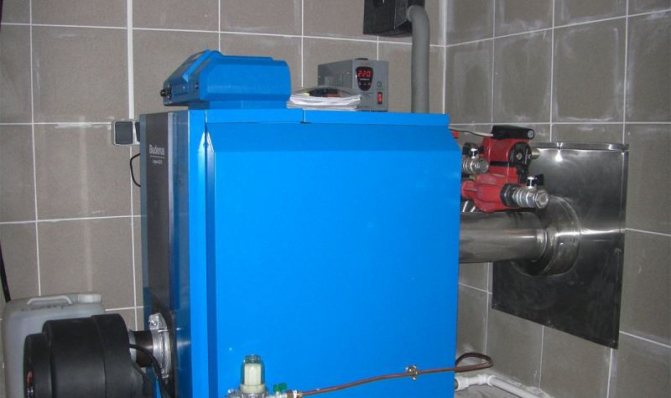

The circulation of the heating medium is identical to all boilers. When choosing a diesel fuel, priority is given to the consumption of diesel fuel per unit of heat or time. It is indicated in the instructions, but it is better to focus on the heated area.


Power is indicated in kW. It is easy to calculate them: the sum of the area to be heated must be divided by ten. For example, 600 to 10. And a boiler is needed with a capacity of at least 60 kW.


The price of diesel boilers, for example, Kiturami (Korea) of this capacity, is within one hundred thousand rubles. Almost compared to solid fuel.
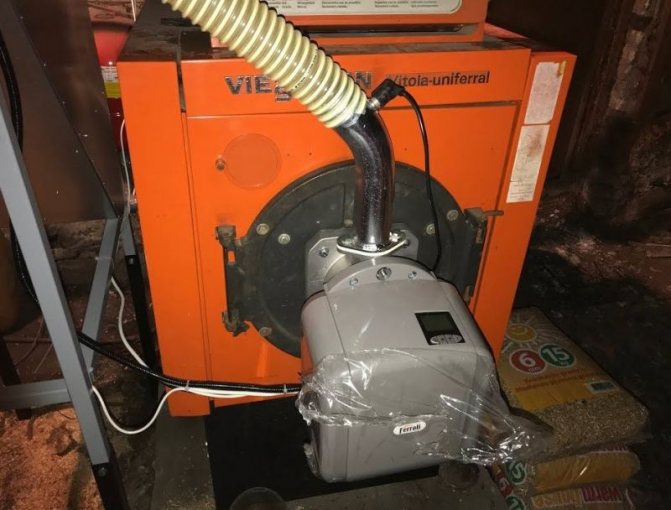

Reviews of diesel fuel boilers: advantages and disadvantages
| Benefits | disadvantages |
| High autonomy - after starting, the boiler does not require any attention at all and is able to work for weeks, it is only necessary to provide the required amount of fuel | The high cost of fuel - when buying at a gas station or even at wholesale prices by ordering a fuel truck |
| High reliability - diesel engines have one of the highest service lives, on average 10-14 years (with a steel heat exchanger) and more (with a copper or cast iron) | All models are exclusively volatile - for the operation of the boiler, it is necessary to provide an uninterrupted power supply |
| High efficiency - on average 90-95%, although budget models still have indicators of 85-89% | Increased noise - the noise from the operation of the burner is noticeable not only during ignition, but also during operation |
| Fuel availability in any region of the country | The need for a separate room for the boiler room - not only because of the noise, but also because of the smell |
| Simpler and more budgetary installation process, no need for permission and project approval | Almost all models are floor-standing |
| Almost all models are equipped with protection against overheating and freezing, stopping the circulation pump |
Installation of a heating system from a diesel boiler and the necessary tools
We use polypropylene pipes. To weld them, you will need a soldering iron, cutters for cutting and stripping from the reinforcing screen.
To tighten the nuts, we stock up on a pair of 32 mm adjustable wrenches.
For fixing pipes to walls, we use special clips. The walls will need to be drilled for hanging radiators, which means that you will need a drill or a hammer drill.
You cannot do without a perforator if you need to remove the chimney in order to cut through a wall or ceiling.
Installation of a diesel boiler and smoke exhaust system
We begin work with the installation of the boiler and the installation of the smoke removal system.
Its design depends on the type of boiler. In its simplest form, it is a short coaxial chimney that can be simply brought out of the room. The pressure required for the discharge of combustion products is provided by a turbine burner.
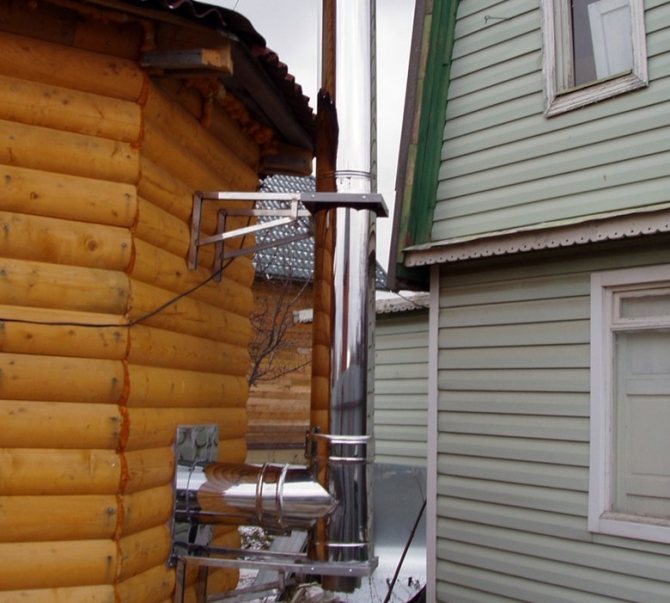

One of the options for the location of a separate chimney for the boiler, fix the pipe on the wall
To output such a chimney in the wall using a perforator, cut a hole corresponding to the diameter of the pipe. We stamp tow and seal the gap between the wall and the pipe with cement mortar. Heat-resistant materials are not needed because the heating of the outer pipe of the coaxial flue is relatively low.
Some boiler models use a vertical chimney. Usually the house already has a suitable chimney, then the task comes down to connecting a boiler to it. For this, a special corrugated sleeve or thin-walled steel pipes are usually used. Finally, the most difficult option is if you need to install the chimney separately.
Two solutions are possible depending on the situation:
a) we bring the pipe to the roof, breaking through the ceiling;
Recommend: How to make electric heating (electric heating) with your own hands
b) we fasten it on consoles to the outer part of the wall.
The second option is more convenient in that it does not affect the interior decoration of the house, but if the heating is installed in the process of new construction, the first is preferable.
Base (foundation) for a diesel boiler
The installation of the boiler is complicated by its weight. Even small boilers weigh about 80 kg, and starting from a power of 16-18 kW, their weight exceeds a hundred kg. Under such a weight, a solid foundation is also required.
Better option for the boiler pedestal is a slab of concrete. We select its size so that it protrudes beyond the dimensions of the boiler and rises by seven to ten centimeters above the floor.
We expose the boiler without distortions, checking with the level. We connect to the chimney.
Now we will install containers for fuel, connect the fuel supply to the boiler.
Tanks with diesel fuel "headache" for liquid fuel boilers. The boiler itself, like the gas boiler, can be placed in the kitchen and even the hallway, there would be ventilation. But tanks with fuel cannot be placed in the living space of the house.
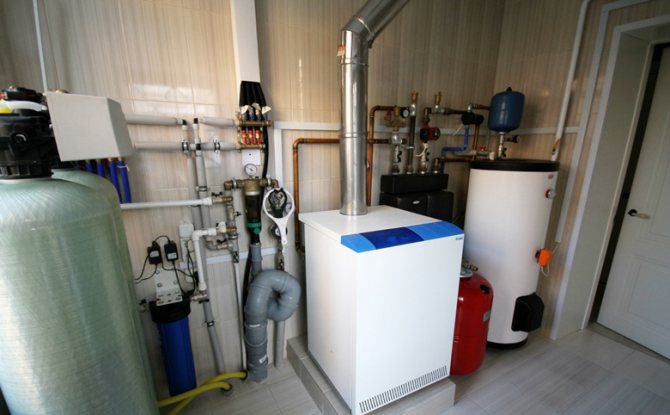

The base for the boiler is a concrete slab protruding above the floor level
The solution may be to place the container on the street, under a canopy. However, in winter you will have to use "winter" diesel fuel, with the addition of kerosene. Common thickens in frost.
Advice
The risk of errors in the installation of the boiler can be reduced by the assistance of a certified specialist. In addition, in some cases, without his participation, you will not be able to obtain the right to warranty service. Before starting work, clarify this point.
After the boiler is connected and checked, it remains to mount the heating system. We start the installation with the installation of radiators, then we lay and connect the pipes. We fill the system with water or antifreeze.
You can read more about the construction of pipelines made of polypropylene pipes in the article on the installation of a water supply system. The only thing that differs from it the laying of heating pipes is that it is advisable to lay the latter with a rise of 1 cm per meter of length towards the radiators. This will help to avoid air pockets in the heating system.
How to choose a diesel heating boiler for a private house
Convection or condensation
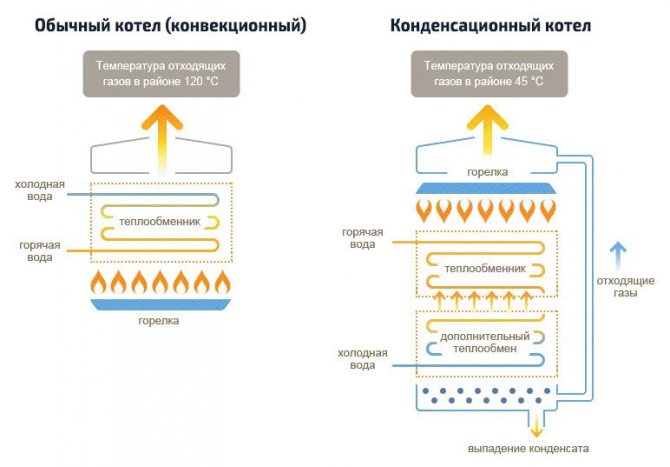

The principle of operation of conventional convection and condensing boilers.
The efficiency, and hence the economy, of a diesel heating boiler depends on the method of using the thermal energy released during the combustion of diesel fuel:
- convection - a standard type of boiler, in which the coolant is heated by direct combustion of fuel, while part of the heat goes away with the combustion products (the temperature of the flue gases is about 75-110 ° C);
- condensing - a modern boiler design, which implies the presence of an additional heat exchanger that extracts heat from the condensate, which in turn is formed from the combustion products discharged into the chimney. Thus, it is possible to accumulate almost all the heat obtained during combustion (the temperature of the flue gases is on average 35-45 ° C).
As a result, the efficiency of condensing boilers is 15-20% higher, however, the cost of such models is 1.5-3 times higher: as a rule, from 100 thousand rubles. Therefore, the payback of this technology depends on the amount of fuel burned.
Wall-mounted or floor-mounted
Due to the large dimensions of the burner and the greater weight of the boiler unit as a whole, diesel boilers are, as a rule, floor standing. There are also wall-mounted models, for example, the Swedish CTC 950 RU. However, at the moment, we do not recommend considering them for purchase: it is difficult to find them on sale, mounted models are 1.5-2 times more expensive than floor-standing counterparts, and the service structure is often not so developed even in Moscow and Moscow Oblast, not to mention the regions. ...
Single-circuit or double-circuit
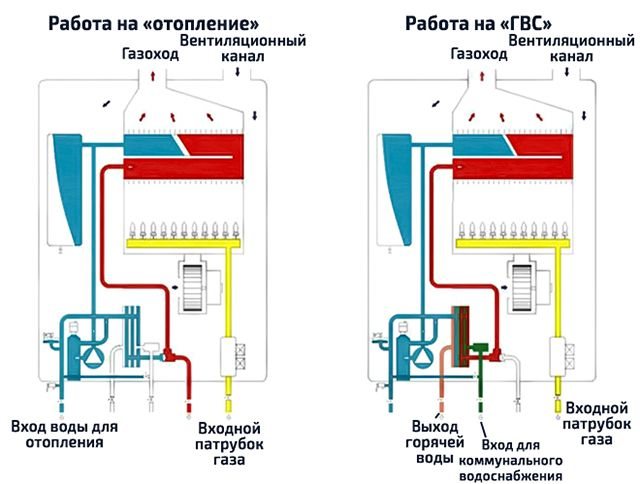

A clear principle of operation of double-circuit boilers with the priority of hot water supply (DHW).
Single-circuit models are designed exclusively for heating. Double-circuit ones have an additional hot water supply (DHW) circuit and when the tap is opened at the point of consumption, they begin to heat up sanitary hot water, which does not mix with technical hot water in the heating circuit. Of course, the choice depends on the requirements for the boiler.
At first glance, it is better to choose a single-circuit boiler, since the cost of fuel is already high. However, two-circuit models are still more effective, this is confirmed by the significantly greater demand for them. The cost of a double-circuit boiler of a budget and medium price category is only 5-15% higher, while organizing hot water supply in a house in a different way will need from 15 to 50 thousand rubles, and the cost of electricity, which will be spent on heating, is higher than the cost diesel fuel.
Heat exchanger material
The heat exchanger is a key element, not only efficiency, but also the durability of the boiler depends on the material of its manufacture, it is partially impossible to replace it, and a full-fledged element is expensive. So, a heat exchanger can be:
- steel - the most simple, lightweight and inexpensive to manufacture, installed on all budget and some models of the middle price segment. The steel heat exchanger is thin and most susceptible to corrosion, even with an anti-corrosion coating, it rarely serves more than 12-14 years. However, a steel heat exchanger is more resistant to temperature extremes and mechanical shock, heats up quickly (but also cools down quickly).
- copper - more expensive to manufacture, but more heat conductive and more resistant to corrosion. The service life of copper heat exchangers is up to 15-17 years (and more).
- cast iron - the heaviest and thickest, practically invulnerable to corrosion. Cast iron heat exchangers take a long time to heat up, but they also retain heat much longer, their service life is more than 25 years. In addition to severity, the disadvantage is vulnerability to temperature extremes and mechanical stress, in other words, the alloy is quite fragile (with the exception of expensive gray cast iron alloys).
How to choose a waste oil boiler for heating a private house
Open or closed combustion chamber


The type of combustion chamber determines the environmental friendliness of the boiler, the ventilation requirements and the choice of the chimney:
- open combustion chamber - classic and most common in gas and TT analogs, however, it is not always justified for diesel boilers. The air required for fuel combustion in an open combustion chamber is taken from the room through openings in the boiler body, and the exhaust is discharged through a classic vertical chimney. This means that in addition to organizing a more complex chimney, high-quality ventilation of the room is necessary, it is also worth mentioning that soot formation and contamination of a boiler with an open combustion chamber is higher.
- closed combustion chamber - most models are equipped with it. To organize work, a simpler and more budgetary coaxial chimney is enough. Air intake takes place through the inner chimney pipe, and the exhaust goes through the outer one. With this principle of operation, the room is less polluted, although the smell of diesel fuel is still present.
Efficiency
The coefficient of performance (COP) is the ratio of the volume of consumed fuel to the volume of heat released and accumulated by the heat carrier, i.e. the efficiency of the heating boiler. If for gas or solid fuel boilers efficiency is not the most important indicator, then for diesel boilers, in view of the high cost of each extra liter of fuel, this is a weighty selection criterion.
As mentioned earlier, the average is 90-95%. Nevertheless, there are excellent models from well-known manufacturers Kiturami and Navien with an efficiency of 86-89%. Despite their lower efficiency, they have an extremely low initial cost, are known for reliability and ease of maintenance, have a developed service structure and readily available spare parts.
It makes no sense to consider models with an efficiency below 86%, otherwise, due to inefficient energy conversion, the cost of their operation will be comparable to that of electric boilers.
Minimum required power
For a standard non-insulated house with 2 bricks masonry and a ceiling height of 2.7 m, located in the climatic zone of the Moscow region, the required power is calculated quite simply: 1 kW for every 10 m2 of heated area. We also recommend setting the power reserve at 15-20%.
For example, for a house with an area of 150 m2, the minimum required power of a diesel boiler = 150: 10 * 1 * 20% = 18 kW. Please note that it is also undesirable to overdo it with power, the boiler will cycle too often, which will lead to faster wear.
How to accurately calculate the required boiler power Individual calculation, formula and correction factors
Additional criteria
Having decided on the main criteria, you can turn to such features as:
- the presence of heat and sound insulation - an additional layer of thermal insulation reduces heat loss through the boiler body itself and increases efficiency, and sound insulation will eliminate the noisy operation of the burner, which is especially important if there are thin walls between the boiler room and the living room;
- automation functionality - the presence of autodiagnostics, heating modes, the possibility of programming work for a day or a week in advance, the presence or ability to connect an external thermostat, weather-dependent control.
Benefits
Let's start right away by considering the winning points (those that are not very good, we will discuss later) that characterize the heating of a country house with diesel fuel. This question is relevant for many owners of private housing, because diesel fuel is not cheap, frankly speaking, a lot of it is required for the heating season.
The rating of this equipment in European countries is quite high, thanks precisely to its advantages. Let's list the main ones.
The efficiency of the discussed equipment is high, reaching 95% under the conditions:
- correct installation of the boiler;
- furnace devices in accordance with all the rules and regulations;
- high-quality insulation of the house;
- installation of double-glazed windows;
- proper storage of fuel supplies;
- use of high-quality fuel;
- timely maintenance;
- competent choice of equipment power, manufacturer, model.
The efficiency can be reached up to 98% when using a condensing type of boiler, but more on that later.
- A wide range of model range, manufacturers, power characteristics, etc.
- Economical consumption of electrical energy.
- Environmental friendliness, which is a fairly relevant trend in modern European society. During combustion, almost no harmful substances and gases are formed.
- High level of safety compared to gas boilers.
- Autonomous, automatic work that does not require constant human intervention.
- Inertia is not typical for the device of diesel boilers (in contrast to solid fuel analogues). Performance drops instantly.
- Liquid fuels take up a much smaller storage area than solid fuels (peat, firewood, coal).
- The ability to use waste machine oils that are cheaper. At the same time, the issue of disposal of waste material is being resolved, which completely burns out in a diesel unit. Again - a reference to sustainability.
The best known manufacturers and models: characteristics and prices
Kiturami Turbo 13R
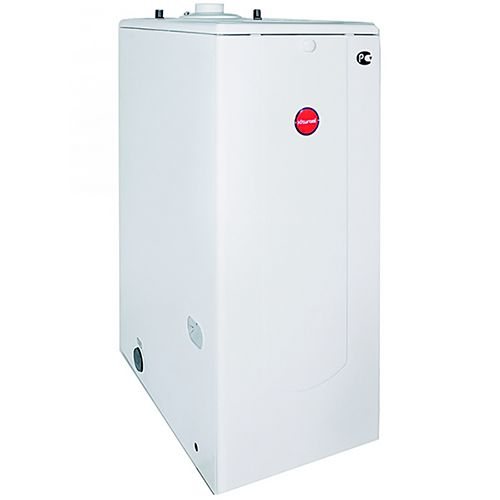

The most common and time-tested Korean double-circuit diesel boiler with a capacity of 13 kW (there are versions of other capacities). Since the boiler is in the budget price category, its heat exchanger is steel, although the secondary (for hot water supply) is copper. Despite the efficiency of 86% and the consumption of up to 1.97 kg / h (2.25 l / h), the model is popular due to its reliability, wide automation functionality and affordable price, one of the lowest on the market.
The main advantage is the presence of a room thermostat in the factory configuration, with the help of which it is possible to more accurately and conveniently regulate the temperature regime (which also affects the efficiency). Also, the automation has various heating modes, self-diagnostics, overheating protection and an anti-freeze mode.
The cost: RUB 29,000-33,500
Navien LST-17KG


Another common Korean double-circuit boiler for diesel fuel with a capacity of 17 kW. Equipped with a steel heat exchanger. It has a higher efficiency of 90% and a lower flow rate - 1.93 kg / h (2.2 l / h). The model is still equipped with a remote control via a room thermostat. A significant advantage is the ability to program the operation of the boiler, which can significantly reduce fuel consumption, for example, by programming a temperature drop to 15 ° C during the absence of the owners at home (work, rest, travel).
According to the owners' feedback and the installation practice, for more than 6 years of operation of these models, almost no single malfunction was observed.
The cost: 33,200-35,000 rubles.
De Dietrich EFU 22 (B-Control)
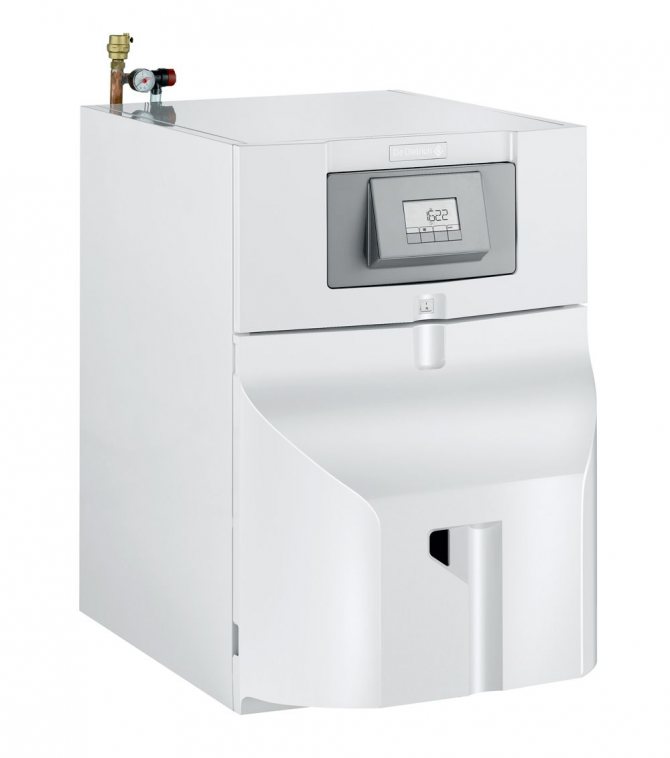

One of the best diesel boilers for heating a private house, especially with an area of more than 200 m2. This is a 22 kW French low temperature single circuit model. It features a durable cast-iron heat exchanger and high efficiency - up to 97.3%. The boiler complies with the highest environmental standards, in practice it works almost silently (thanks to a heat exchanger with three-way gas removal and sound insulation). Has functional controls, auto ignition, the ability to connect an external thermostat (it is not included in the kit). The only drawbacks are its heavy weight (185 kg) and high cost.
Please note that the boiler has an open combustion chamber and an atmospheric burner, therefore it needs natural ventilation through a classic vertical chimney.
The cost: 116,000-135,000 rubles.
Ferroli ATLAS 32
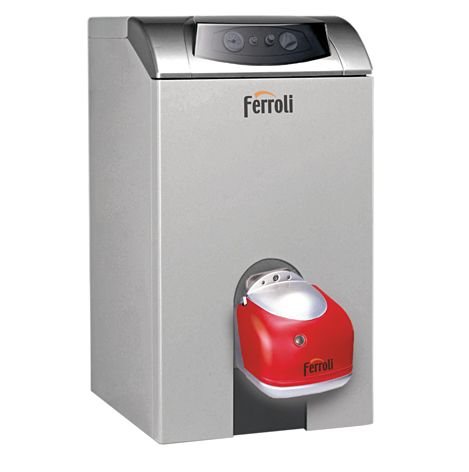

Universal Italian single-circuit model with replaceable burner (diesel - burner SUN G, gas - SUN M) with a capacity of 32 kW. It features high reliability and efficiency up to 94.3%, as well as a durable cast-iron heat exchanger. There is protection against overheating and freezing, it is possible to connect an external thermostat. The boiler works almost silently, but has an open combustion chamber.There were no obvious shortcomings in the experience of installation and operation.
The cost: 53,500-61,000 rubles. + Ferroli SUN G burner - 25-29 thousand rubles.
Lamborghini AX 3 32
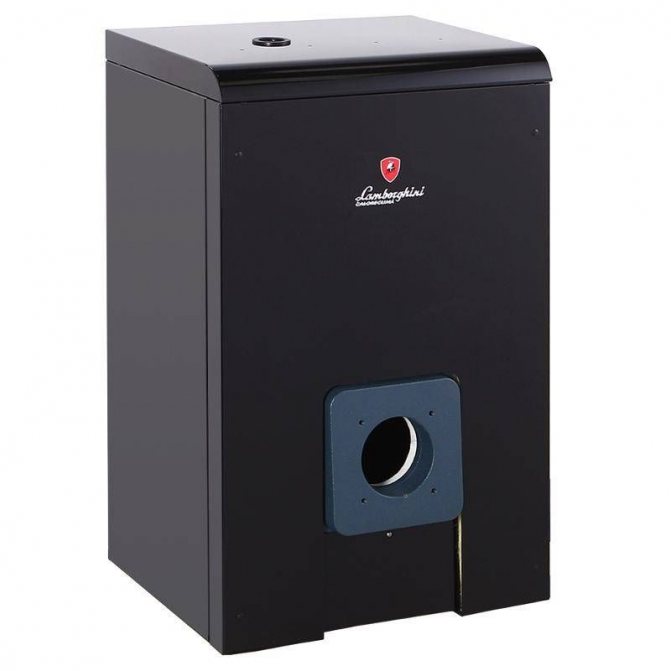

Another Italian universal single-circuit boiler with a replaceable burner (gas-diesel) with a capacity of 32 kW. It practically does not differ from the previous analogue, it is equipped with the same cast-iron heat exchanger with a three-way exhaust of gases, is known for its reliability, has a stylish design. However, it has a lower efficiency of 91.6% and more limited functionality (external control connection is possible). There is a layer of thermal insulation under the body, and the ease of operation and maintenance can also be noted.
The cost: 51-65 thousand rubles + Lamborghini Fire 3 burner - 22 600-27 000 rubles.
The best diesel boilers
The Russian market of heating equipment offers diesel boilers from the following well-known world manufacturers:
- German, Viessmann, Vaillant, Buderus;
- French De Dietrich;
- Slovak Proterm;
- Italian Ferroli;
- Czech Dakon;
- Spanish Roca.
According to consumer reviews, all of these DK brands are reliable and economical, have a long service life. The choice of Europeans is De Dietrich, French boilers that have seriously competed with German devices.
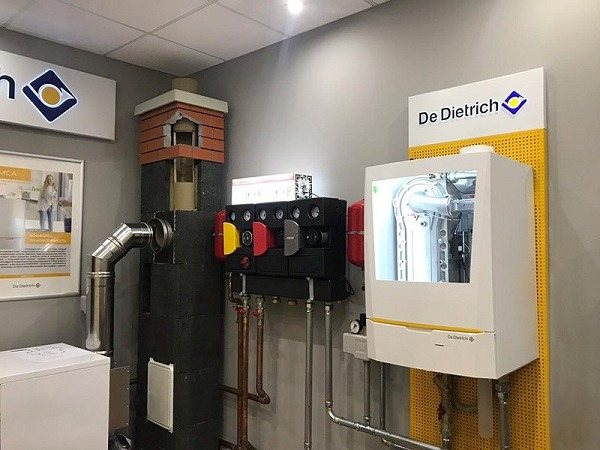

A Russian buyer prefers budgetary DK brands made by:
- By Korean boiler manufacturers, diesel boilers Kiturami and Navien.
- Italian factories, Fondital Capri and Nova Florida.
- Diesel boilers ACV, Belgian production.
- The brands of boilers that have recently entered the market are Finnish DanVex and American EnergyLogic EL.
The prices for recreation centers depend on the brand of the manufacturing plant, the design capacity and the level of automation. German ones are sold at prices of 110-150 thousand rubles. with basic equipment. The line of diesel boilers Kiturami of Korean manufacturers is sold in the range from 55-90 thousand rubles.
Additional equipment is purchased separately. On the modern market there is a wide selection of domestic liquid fuel boilers with an initial price range of 28,000 - 30,000 rubles. This price corresponds to a 16 kW unit with 90% efficiency.
It is important to note that the set of automatics, for example, Navien diesel boilers, includes a remote control, overheating protection, autodiagnostics and emergency stop.
Prices: summary table
| Model | power, kWt | Number of contours | Efficiency,% | price, rub. |
| Kiturami Turbo 13R | 13 | double-circuit | 86 | 29 000 |
| Navien LST-17KG | 17 | double-circuit | 90 | 33 000 |
| De Dietrich EFU 22 (B-Control) | 22 | single-circuit | 97,3 | 116 000 |
| Ferroli ATLAS 32 | 32 | single-circuit | 94,3 | 80 000 |
| Lamborghini AX 3 32 | 32 | single-circuit | 91,6 | 74 000 |
Installation and connection
The process of installing diesel boilers does not differ from gas or solid fuel counterparts and is carried out in accordance with SNiP 41-01-2003 "Heating, ventilation and air conditioning" and SP 7.13130.2009 "Heating, ventilation and air conditioning. Fire safety requirements ". Works are carried out at temperatures not lower than + 5 ° C.
The boiler piping also does not differ from that used for the installation of analogs, an example of a classic connection diagram to a closed-type system is shown in the photo below.


Diagram of connecting a diesel boiler to a closed heating system.
All overall and connection dimensions as well as a detailed installation algorithm are always described in the boiler operating instructions, today an electronic copy of the instructions for any of the models can be found on the Internet. Please note that installation, adjustment and the first start-up must be carried out by a certified specialist who will put the appropriate stamp in the boiler passport: without it, most manufacturers refuse warranty obligations.
What is needed for a diesel heating device
First of all, of course, the diesel boiler itself. The more area you need to heat, the more powerful it is needed.
There are two types of boilers:
- for heating only;
- for heating and hot water supply, or double-circuit.
In operation, the differences are insignificant, and at a price the two-circuit ones are about a quarter more expensive.
The water heated by a double-circuit boiler is quite enough for everyday household needs. Except perhaps the shower. The boiler does not keep up with its water consumption. However, if you do not make a strong pressure, you can take a shower.Everything else - take a bath, wash dishes, brush your teeth, wash - no problem.
Only in warm weather, in order to heat the water, you have to start the entire boiler, which is inconvenient, therefore the double-circuit boiler is still supplemented with a separate water heater.
From practice: a combination of a double-circuit boiler plus a boiler is certainly more expensive than a boiler and a single-circuit boiler. However, the first option is much more convenient in operation. And due to the lower load on the boiler, in the end, it turns out to be more profitable.
Another necessary device is a fuel container. Their volume is selected depending on the fuel consumption.


Capacity for storing diesel. fuel is not just a tank, but a whole complex of devices that provide storage and supply of fuel. There are also simplified options.
The fuel tank is not just a plastic or steel tank. It is equipped with a list of accessories. Of these, the most important are:
- "Breathing" valve is designed to compensate for the pressure inside the container;
- device for determining the degree of fuel reserve;
- fuel intake device;
- drain valve for periodic cleaning of the tank from sediment.
Recommend: Warm water floor from a gas boiler
Maintenance
A feature of boiler equipment using any fuel is the formation of soot inside the combustion chamber and chimney, the formation of scale inside the heat exchanger, clogging of the nozzles and the fuel filter, all this not only reduces the efficiency by 25-30%, but can also lead to more serious malfunctions. Therefore, regular maintenance consists exclusively of inspection and cleaning, it can be carried out not only upon the call of specialists, but also by yourself, while the guarantee remains relevant.
Regularity - at least once every 3-5 years, we recommend cleaning the boiler once every 1-2 heating seasons and flushing the heat exchanger every 4 years.
- Cleaning and flushing the heat exchanger... When hard untreated water is used as a heat carrier, scale and other salt deposits form on the inner walls of the heat exchanger, which reduce its cross section and thermal conductivity. It can be cleaned mechanically, using a solution of citric or hydrochloric acid, or without removing it from the boiler, by hydrodynamic flushing. We have already described the detailed algorithm for cleaning the heat exchanger earlier, it is the same for boilers using any fuel.

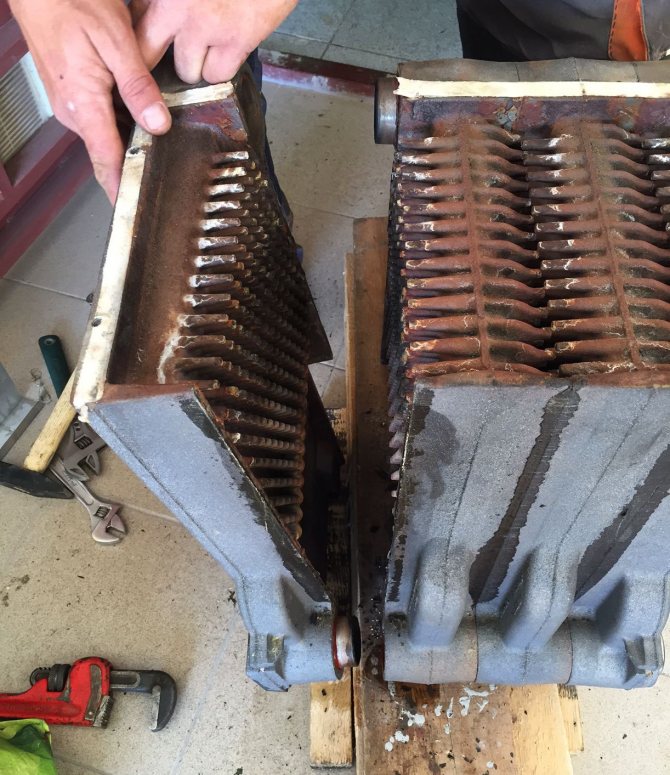
Soot and rust inside the cast iron heat exchanger sections. - Cleaning the burner, combustion chamber and outer walls of the heat exchanger... During operation, soot forms on these elements, debris and dust from the room are retained, a layer of at least 0.5 cm reduces the efficiency by more than 10%. The cleaning process also does not differ from analogues, with the exception of a different burner design (we also described it earlier).
- Cleaning or replacing the fuel filter... The fuel filter is not installed in many models of diesel boilers, but it is an extremely important component, since both the degree of soot formation and the service life of the boiler depend on the quality of fuel cleaning. And given the quality of domestic diesel fuel, a fine and even coarse filter, their regular cleaning or replacement is just a necessity.
The most common consequences of a lack of regular maintenance are:
- Parasitic flame... The logic is to receive a signal from the ionization sensor about combustion before the board gives a signal to open the fuel valve / injectors. To solve the problem, it is enough to clean all the components of the burner. Rarely fluid spills on the electronic control board.
- The boiler is smoking heavily... The classic consequence of clogged injectors: due to the lack of a fuel filter or during the process of soot formation. In open chambers, clogging can also occur due to dustiness in the room or repair work.To solve the problem, it is enough to remove the burner, carefully clean and blow out the nozzles.

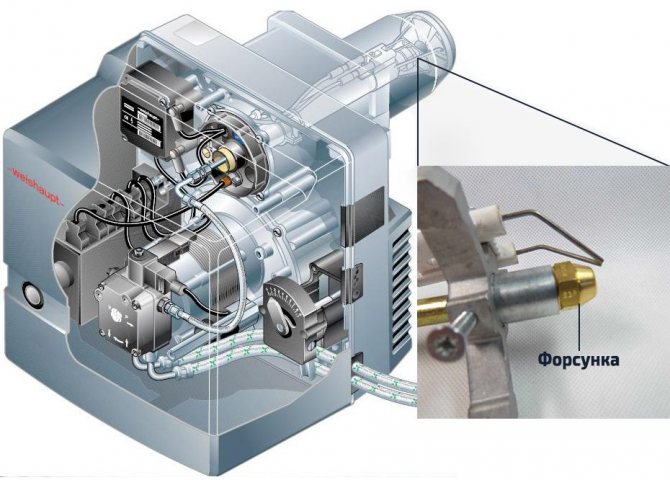
The location of the nozzle in the diesel burner.
Diesel boiler functioning diagram
Equipment for heating a private house works according to the following scheme:
- The fuel pump and the combustion air supply system are activated.
- The pump transfers fuel from the storage tank to the combustion chamber. Here the fuel material is filtered and heated.
- The nozzle pressure increases to 10-16 atmospheres. This is enough to spray the fuel into suspension.
- The electric ignition is switched on.
- The atomized fuel mixes with the forced air and ignites from an electric spark.
- The heat energy released during combustion enters the heat exchanger, heats the coolant.
- The coolant circulates through the heating devices, heating the rooms of the house.
- If a condensing boiler is running, the thermal energy of the gases emitted is also used for heating.
- The products of fuel combustion are removed by the chimney outside the house.
